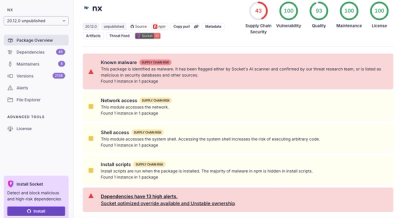
Security News
Risky Biz Podcast: Making Reachability Analysis Work in Real-World Codebases
This episode explores the hard problem of reachability analysis, from static analysis limits to handling dynamic languages and massive dependency trees.
@healthcatalyst/fabric-access-control-ui
Advanced tools
An Angular 5 routed module for managing access in Fabric.Authorization
An Angular 5 routed module for managing access in Fabric.Authorization
Run npm i --save @healthcatalyst/fabric-access-control-ui
This module requires Health Catalyst Cashmere so that should be installed as well
The access control module is lazy loaded and should be imported into a module that will assist with loading it through the router and with providing the configuration data. A class that implements IAccessControlConfigService should be created and registered as a provider in this module.
You should not import the access control module directly in your root module
Here is an example of a helper class and an implementation of the configuration class that will be used by the access control module. Notice that you can inject things via the constructor into the configuration class to take advantage of the host applications configuration service.
import { NgModule, Injectable } from '@angular/core';
import { AccessControlModule, IAccessControlConfigService } from '@healthcatalyst/fabric-access-control-ui';
import { IDataChangedEventArgs } from '@healthcatalyst/fabric-access-control-ui/src/app/models/changedDataEventArgs.model';
import { Exception } from '@healthcatalyst/fabric-access-control-ui/src/app/models/exception.model';
import { Subject } from 'rxjs/Subject';
import { Config } from './app.module';
@Injectable()
class AccessControlConfig implements IAccessControlConfigService {
dataChanged: Subject<IDataChangedEventArgs> = new Subject<IDataChangedEventArgs>();
errorRaised: Subject<Exception> = new Subject<Exception>();
clientId = 'atlas';
identityProvider = 'windows';
grain = 'dos';
securableItem = 'datamarts';
fabricAuthApiUrl = this.config.AuthUrl;
fabricExternalIdpSearchApiUrl = this.config.IdpSearchUrl;
constructor(private config: Config) {
this.dataChanged.subscribe((eventArgs: IDataChangedEventArgs) => {
console.log(`Data changed: ${JSON.stringify(eventArgs)}`);
});
this.errorRaised.subscribe((eventArgs: Exception) => {
console.log(`Error: ${JSON.stringify(eventArgs)}`);
});
}
}
@NgModule({
imports: [
AccessControlModule
],
providers: [
{provide: 'IAccessControlConfigService', useClass: AccessControlConfig}
]
})
export class AccessControlLazyLoader { }
You can then wire the access control module up via the router using the lazy loader module.
The loadChildren value must point to the location of the lazy loader module
{ path: 'access-control', loadChildren: './access-control-lazy-loader#AccessControlLazyLoader' }
Ensure your root module imports HttpClientModule
import { HttpClientModule } from '@angular/common/http';
The access control module needs to be installed into an application that can get an access token with scopes to read and write to the Fabric.Authorization API. This access token needs to be provided in each http request to Fabric.Authorization. We require Http Interceptors for this. Here is an example from a sample application of an http interceptor that will add the required headers.
import { Injectable } from '@angular/core';
import {
HttpInterceptor,
HttpRequest,
HttpHandler,
HttpEvent
} from '@angular/common/http';
import { Observable } from 'rxjs/Observable';
import 'rxjs/add/observable/fromPromise';
import 'rxjs/add/operator/mergeMap';
import { AuthService } from '../services/auth.service';
@Injectable()
export class FabricHttpRequestInterceptorService implements HttpInterceptor {
protected static readonly AcceptHeader = 'application/json';
protected static readonly ContentTypeHeader = 'application/json';
protected static AuthorizationHeader = `Bearer`;
constructor(private authService: AuthService) {}
intercept(
req: HttpRequest<any>,
next: HttpHandler
): Observable<HttpEvent<any>> {
const tokenObservable = Observable.fromPromise(
this.authService.getUser()
.then((user) => {
if(user){
return user.access_token;
}
})
);
return tokenObservable.mergeMap(accessToken => {
const modifiedRequest = req.clone({
setHeaders: {
Authorization: `${
FabricHttpRequestInterceptorService.AuthorizationHeader
} ${accessToken}`,
Accept: FabricHttpRequestInterceptorService.AcceptHeader,
'Content-Type': FabricHttpRequestInterceptorService.ContentTypeHeader
}
});
return next.handle(modifiedRequest);
});
}
}
FAQs
An Angular 5 routed module for managing access in Fabric.Authorization
The npm package @healthcatalyst/fabric-access-control-ui receives a total of 7 weekly downloads. As such, @healthcatalyst/fabric-access-control-ui popularity was classified as not popular.
We found that @healthcatalyst/fabric-access-control-ui demonstrated a not healthy version release cadence and project activity because the last version was released a year ago. It has 10 open source maintainers collaborating on the project.
Did you know?

Socket for GitHub automatically highlights issues in each pull request and monitors the health of all your open source dependencies. Discover the contents of your packages and block harmful activity before you install or update your dependencies.

Security News
This episode explores the hard problem of reachability analysis, from static analysis limits to handling dynamic languages and massive dependency trees.

Security News
/Research
Malicious Nx npm versions stole secrets and wallet info using AI CLI tools; Socket’s AI scanner detected the supply chain attack and flagged the malware.

Security News
CISA’s 2025 draft SBOM guidance adds new fields like hashes, licenses, and tool metadata to make software inventories more actionable.